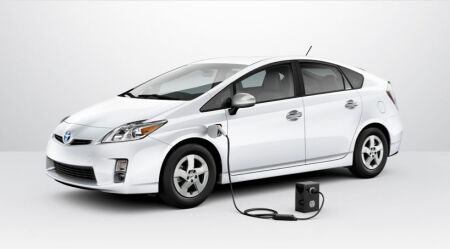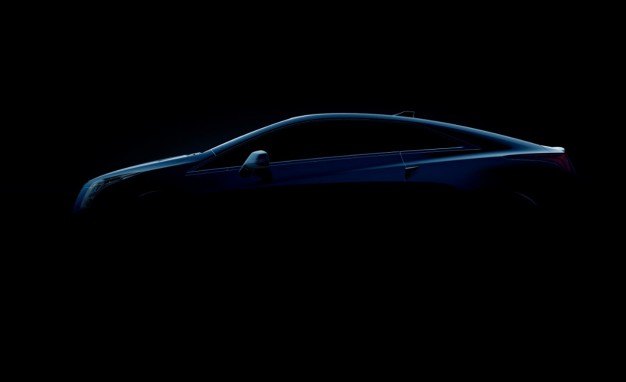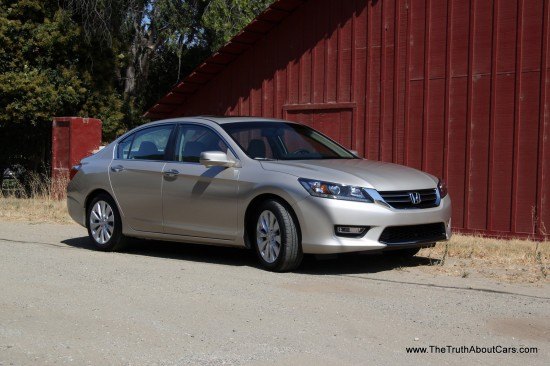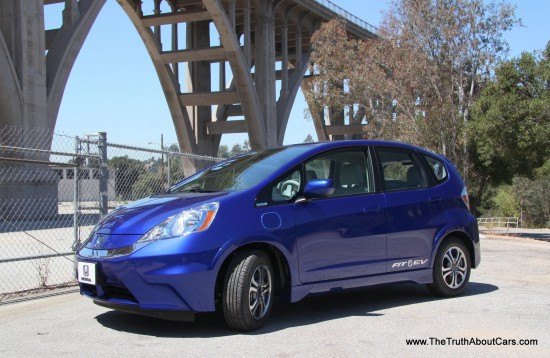#Plug-in
QOTD: What Sound Should Hybrids And EVs Make Below 18 MPH?
NHTSA is proposing to make it mandatory that hybrid cars and EVs have the ability to emit a sound when traveling below 18 mph on electric power, as a means of warning pedestrians and cyclists. The system is said to add about $30 to the cost of each vehicle, and will no doubt tie up bureaucrats for months as they debate just what kind of tone will best protect the public from the horror of low-speed injuries. So why don’t we make life easier for them and decide ourselves?
Oregon Considers Per-Mile Tax On Fuel-Efficient Vehicles
“Everybody uses the road and if some pay and some don’t then that’s an unfair situation that’s got to be resolved,” said Jim Whitty, manager of the Oregon Department of Transportation’s Office of Innovative Partnerships and Alternative Funding.
Ah, yes. As with any number of current governmental activities, the rationale for per-mile taxation will be fairness.
Cadillac Teases ELR
A123 Wants to Void Contract With Fisker, Fisker Says That Would Disrupt "Ongoing Business"
While Johnson Controls and China’s Wanxiang Group have competing bids to acquire the assets of advanced battery maker and Fisker supplier A123, a more serious battle is occurring in U.S. Bankruptcy Court in Delaware between the startup automaker and what is arguably its most important vendor. A123 wants the bankruptcy judge to void its contracts including those for supplying batteries to Fisker. That could stop production of Fisker’s only car, the Karma.
Pre-Production Review: 2013 Honda Accord – Part 2
Five days ago we released the first part of the 2013 Accord review. It’s not how we normally do things, but in order to get our hands on the second best-selling mid-size sedan in America we had to agree to keep you all in suspense. If you want to know about the new Accord’s drivetrain, interior and infotainment systems, click on over to part one and then head back here when you’re done. I promise we’ll wait for you.
Pre-Production Review: 2013 Honda Accord, Part 1
Redesigning the second best-selling midsize sedan in America is no easy task. It’s also one that doesn’t happen very often for fear of getting it wrong. Still, even with all the bad press the new Civic received, sales have been booming. By all appearances this has not made Honda sit on their hands however when it came to the new Accord. Honda invited us to Santa Barbara to sample the all-new, smaller, 9th generation Honda Accord. This is a bold launch event with not just a new engine and transmission under the hood, but an all new hybrid technology on offer as well. If you want to know how it drives, or how much it costs, our Honda overlords have decreed our lips must be sealed until the 10th at 6AM Eastern. Set yourself a reminder then click-through the jump for part one.
Review: 2012 Toyota Prius Plug-In Hybrid
Public beta tests are common in the computer world where a group of fanatics pound your beta to death and help you find the problems. In the automotive world this activity is not only rare, it runs contrary to the cash spent on dressing future cars in swirly vinyl. The Prius plug-in is different. Toyota built 600 demonstrators and sent them to large corporations, Zipcar fleets and, of course the press. Even TTAC was allowed to drive one for a week. What does that have to do with the final product? And how does it stack up against the Volt, Plug-in Fusion and the 2013 Accord Plug-in? Let’s find out.
Plug-In Car Sales Breakdown: June 2012
Now that the dust has settled, it’s time to take a look at our favorite automotive urination competition, the epic battle between the Chevrolet Volt, Nissan Leaf and the Toyota Prius Plug-In.
Pre-Production Review: 2013 Honda Fit EV
Despite accounting for an incredibly small percentage of new car sales in America, the EV is all the rage in California. Rather than starting from scratch and designing an all-new car from the ground up (like Nissan), Honda chose the more economical route and electrified the second-generation Honda Fit. On the surface, the recipe sounds like a slam dunk, since the Fit is one of Honda’s most attractive and most fun to drive models now on sale. To prove to the masses that Honda has what it takes to go green, they flew me out to Pasadena to sample the all-new, all-blue Fit EV.
April Plug-In Car Sales: Toyota Prius Wins, Chevrolet Volt Takes Second, Nissan Leaf Third
It was a good month for the Toyota Prius Plug-In, with the newest plug-in car outselling the Chevrolet Volt and Nissan Leaf in April.
Geely Plug-In To Use Same Battery Supplier As Fisker
Geely has chosen their battery technology partner for their new plug-in hybrid vehicle, and their supplier, A123 Systems Inc., may not be a familiar name to everyone, but their wares have been used by other vehicles like the Fisker Karma.
Another Plugin Problem: A123 Warns Of "Potential Safety Issue" With Fisker Karma Battery
In the ramp-up to the launch of the Chevy Volt and Nissan Leaf, a great debate seized the engineering community: was Nissan opening itself to problems by not including a active thermal management system for the Leaf’s battery pack, or was Chevrolet’s liquid-cooled approach simply adding unnecessary complexity? Well, thus far, the verdict seems to be in Nissan’s favor. Though Leaf has been troubled by some dissatisfaction with its real-world range, the Volt has endurd the first technical semi-scandal of the plug-in era, when federal regulators found that ruptured coolant lines could cause fires. Now the liquid-cooled approach is hitting its second challenge, as Fisker’s battery supplier A123 Systems is warning in a letter [ PDF] that
some of the battery packs we produce for Fisker Automotive could have a potential safety issue relating to the battery cooling system.
Ruh-roh!
Chart Of The Day: The Chevrolet Volt's Sales Challenge
Is the Chevy Volt a flop? It’s a question that plenty of folks both inside the industry and beyond seem awfully curious about, and one that I’ve tried to stay away from until we had some strong data to go on. And with nine months of 2011 under our belt, we’re starting to get a sense of where the Volt is going… and it’s not been all reassuring news. Jalopnik notes that such unloved GM models as the Buick Lucerne and Chevy Avalanche outsold the Volt last month, but failed to look at the important stuff: production as compared to deliveries, and inventory. Jalopnik does quote a Cars.com inventory figure of 2,600 Volts on dealer lots, although the latest data we have from Automotive News [sub] shows 1,400 units in the national inventory as of September 1… which at that point constituted a 121-day supply. Add in the 1,644-unit differential between Volts built and Volts sold in September, and the estimated Volt inventory across the nation should be closer to 3,000 units. We will be sure to update when AN gets new inventory numbers, but for now, the signs aren’t promising.
Report Knocks "Big Battery" Plug-In Subsidies, Will The DOE Notice?
The main tool for the government’s crusade to get one million plug-in cars on the road by 2015 is the “Qualified Plug-In Electric Vehicle Tax Credit,” a credit that returns between $2,500 and $7,500 to purchasers of a qualifying vehicle. To qualify for the minimum $2,500 credit, a vehicle must have a traction battery with a minimum of four kW/h, and the credit adds an additional $417 in credits for every kW/h above the minimum. Why? Well, you might think that it’s because the DOE has done its research and determined that larger battery packs deliver more social benefits… at least until the 16kW/h limit (the exact size of the Chevy Volt’s battery), where the credit tops out at $7,500. But according to new research by Carnegie Mellon’s Jeremy Michalek, that basic assumption doesn’t appear to be true at all. In fact, his latest paper argues that the government would actually be better off subsidizing smaller, not larger, battery packs.
Truth Versus Advertising: Sex Is Sexier Than The Environment Edition
With the environment taking an ever-larger place in automotive advertising, it’s interesting to note that Fisker’s latest brochure puts green in its place: behind sexy. Of course these sultry images [via BusinessInsider] aren’t free from environmental overtones, featuring taglines like “designed to get you hot, not the planet,” but it’s clear that Fisker is more heavily relying on the most traditional tool in the advertising playbook. Why? For one thing, even though Fisker is delivering Karmas, the EPA has not yet certified its efficiency rating… so we don’t even know how environmentally friendly it is yet. For another the Karma’s main rival, Tesla’s forthcoming Model S, is pure electric and therefore more appealing to wealthy environmentalists. Finally, unlike environmental messaging, sex doesn’t remind people that Fisker was the beneficiary of over half a billion dollars in government loans. Plus, sex is still, well, sexy. The more things change, the more they stay the same…



























Recent Comments